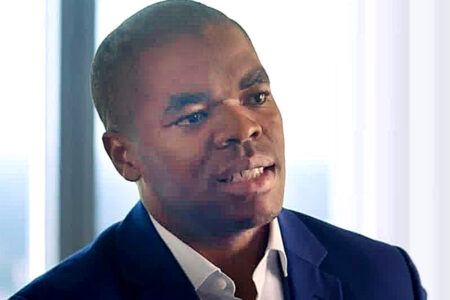Electronic trading may resolve key structural challenges in the market for buy-side traders, including instrument selection, with guidance from key dealers.

Chinedum Nzelu, head of macro e-trading at JP Morgan, told with The DESK how he sees buy-side traders getting the greatest value from electronic trading and their partnerships with sell-side firms.
What does it mean to be a strategic execution consultant to your buy-side clients?
As trading capabilities advance, clients need to explore new execution methods across both electronic and voice channels, as well as bilateral and multilateral trading. We develop our services in parallel to minimise the risk of service/ demand mismatches.
Clients frequently inquire about our tool development processes and our strategic thinking. These conversations often lead to stronger relationships, especially when clients build API solutions for their electronic trading. Even when clients do not develop an API, the more they understand our approach, the stronger our relationship becomes.
How is technology changing the way you engage with clients?
Investment in technology has always been a cornerstone of JP Morgan’s market strategy. We focus on building intellectual property (IP) and transforming traditional businesses into more sustainable, future-proof solutions.
Where do you start with that?
Data capture is the foundational step. To generate prices in various asset classes, you must first capture the data, convert it, and then distribute it automatically. A prime example is the repo markets, which have traditionally relied on voice communication, primarily through chat functions. By investing in data capture around workflow, we were able to develop a processor to convert structured data. This enabled us to implement automated pricing, significantly enhancing our throughput. While salespeople and traders remain involved, overall efficiency has greatly increased.
What sort of services have you developed to support clients?
One example is Data Query, a service we offer that packages captured data, allowing clients to access to analytics via JP Morgan Markets. Internally, developing similar analytics helps us gain a deeper understanding of the markets. Another notable example is Algo Central, our analytical platform available via our proprietary platform JP Morgan Markets and via 3rd party platforms. This solution is expanding across FX and rates, with plans to extend into credit in the future. Without precise market data, pricing data, and client data, combined with our unique models, these products would not be possible. They are unique in our industry, and we are continually exploring new innovations.
The emergence of data as a commercial asset is driving increased automation in our products and enabling the creation of solutions that were previously unimaginable.
Which aspects are driving client demand for services?
In my opinion, elections have been a significant macro concern, contributing to heightened volatility this year, primarily driven by central bank rate hike cycles, speculation, and macro indicators such as CPI data. The key difference between unpredicted and scheduled volatility – such as elections – is that scheduled events typically prompt people to onboard platforms in advance. This preparation ensures they have access to our liquidity providing a more reliable and consistent flow of information, even during turbulent events.
How does that directly impact client demand?
The level of onboarding rises to ensure that firms can confidently access price streams, which are essential for risk assessment and pricing. For instance, during recent market volatility, we observed record volumes on most platforms, although trading during that period was challenging.
From an electronic trading perspective, we leverage these situations for research. When volatility prompts clients to incorporate flexibility into their execution strategies, it facilitates rapid onboarding with strong trading partners. We are consistently available in both stable and volatile market conditions.
What is driving innovation between bilateral and multilateral trading?
There is a clear divide between legacy multi-dealer offerings and highly innovative single-dealer solutions, which is likely to increase competition among platform providers due to the costs associated with service-based platforms.
Trading platforms will need to become more competitive. As clients demand more efficient electronic trading for price discovery, execution and post trade analytics, this demand will drive innovation. Consequently, we can expect the development of more products and platforms over time.
Increased competition among dealers and service providers will naturally raise the costs associated with maintaining service-based platforms.
How is expansion of electronic manifesting in markets?
In mature markets like foreign exchange, there is still room to increase the amount of risk available to clients, although many of the pricing and distribution mechanisms are already well-established. On the other hand, in markets that are relatively new to electrification, such as credit, a limited number of venues currently dominate. There remains significant potential for advancement in both credit and rates markets.
As Kate Finlayson, JP Morgan Global Head of FICC Market Structure & Liquidity Strategy, has observed “there are a number of structural changes emerging which could support increased electronic trading. The development of an appropriately calibrated consolidated tape in both the EU and the UK will provide additional data points which could work to accelerate e-trading.”
In very manual markets like municipal bonds, specialists can offer electronic solutions, but the market structure is not conducive to high volume and high throughput, so it may still rely on voice trading.
In the realms of rates, credit, and emerging markets, electronic trading can be facilitated through RFQ (Request for Quote) protocols managed by humans via electronic channels, and through electronic streaming protocols that cannot facilitated by a human.
We are observing a growing demand for streaming protocols. I believe this trend is likely to continue and eventually incorporate algorithmic execution models. These models may not mirror the FX structure, which involves homogeneous instrument execution, but will instead focus on strategic target execution. This approach will make it easier for clients to target positions or risk, across a vast universe of bonds.
©Markets Media Europe 2024
©Markets Media Europe 2025












